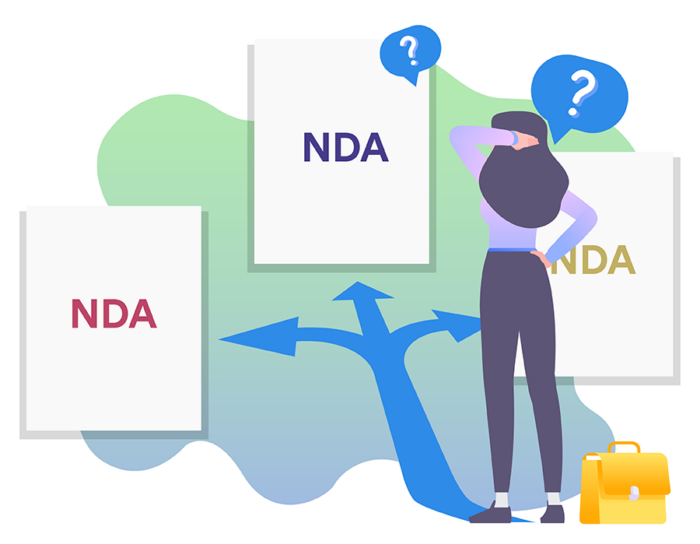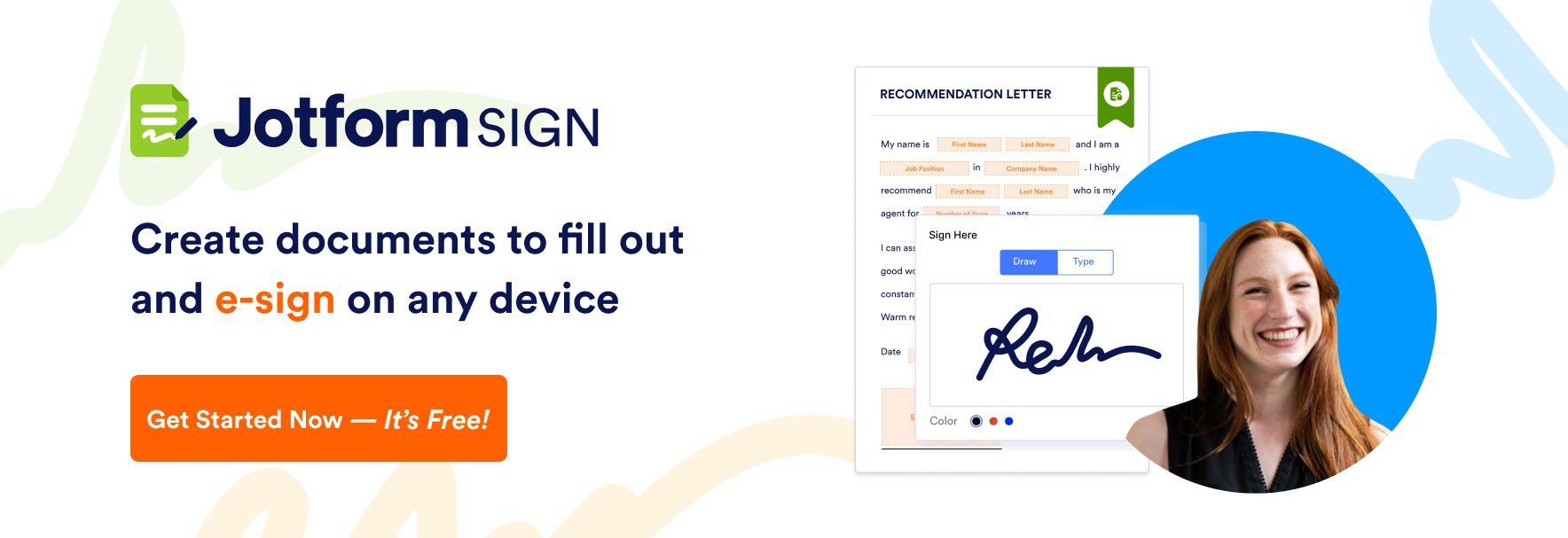Legal contracts aren’t for the faint of heart. Unless you’re a lawyer, you probably don’t feel confident creating an agreement that would hold up in court. Yet if you’re a small business owner, you probably don’t have the budget to hire a lawyer every time you need help with a legal matter, like when you need to draw up a nondisclosure agreement.
If you’re not even sure what this common legal instrument is or what it’s used for, don’t worry. It’s a common question: What is the purpose of a nondisclosure agreement? Let’s clear that up. A nondisclosure agreement, or NDA, is a legally binding contract that aims to keep the person receiving the other’s confidential or sensitive information from sharing it with anyone else.

In this guide, you’ll learn a lot more about NDAs, including why and when to use them and which type is best in a given scenario. (Yes, there are different types of NDAs!) Check out the chapter synopsis below to get a sneak peek, then keep scrolling for insights on how to protect your organization’s confidential information.
Chapter synopsis
- Introduction.
- Why and when to use an NDA. Gain greater insight into why you should use an NDA in business. Plus, learn about common use cases where employing an NDA makes sense.
- Elements to include in an NDA. What are the must-have elements to ensure your NDA is the information protection tool it’s intended to be? Find out in this chapter.
- Types of NDAs. There are different types of NDAs. In this chapter, you get the rundown on a few and learn how they differ.
- Online NDAs. NDAs are no longer limited to endless printed pages. See how NDAs are going online, and how you can easily create an NDA from a ready-made template and employ it in your business.
Remember to bookmark this guide for later reference.
Why and when to use an NDA
“NDAs exist to keep secrets,” says Ruth Carter, an Arizona attorney and authority on intellectual property, business law, and internet law. Secrets abound in business, whether in the form of proprietary business processes, confidential company data, coveted recipes, trade secrets, a company’s “secret sauce”, or client lists, etc. Anytime you’ve got secrets that, if leaked, could threaten the profitability or competitive edge of your business, you need to protect against that, and an NDA can be a great way to do it.
Common NDA use cases
Carter provides several common use cases where an NDA would be applicable:
- Discussing mergers, acquisitions, and partnerships. When two or more companies come together to discuss ways they can better corner the market, reach new heights in the industry, reduce costs, and so on, it’s important to use a legal instrument that ensures confidential information doesn’t leave the conference room. “For a fruitful discussion about merging or partnering, participants need to be able to talk freely. An NDA gives them the power to do so,” says Carter.
- Accepting legal settlements. If you’ve ever seen news about celebrities being involved in lawsuits that were quietly resolved or concluded, there was probably a legal settlement involved with non-disclosure language or a full NDA included.. “NDAs are often part of legal settlements, which often prevent the involved parties from talking about details of the case,” Carter explains.
- Hiring independent contractors. When an employer hires external help from service providers, these providers typically need access to what the company would consider confidential or sensitive information. Otherwise, the contractors won’t be able to fully perform their services. “For example, you may hire a copywriter to create marketing materials for a new product you’re launching. To safeguard the knowledge of the product, have the writer sign an NDA,” says Carter.
- Onboarding new employees. Bringing new employees into your company means they will gain access to a wealth of confidential information you don’t want competitors or the public to know. Even if some of the information is shared with only certain roles, such as senior managers, NDAs are still essential to limit disclosure. Carter provides two examples: “Coca-Cola can’t have its secret recipe leaking. And on a more general level, a business wouldn’t want the security codes for its building getting out.”

For employer-employee agreements, employees are usually required to protect confidential information to at least the same degree they protect their personal information. That means not just intentionally sharing company info with others, but also letting others see it. For example, they shouldn’t leave confidential company info showing on a laptop screen when they walk away from their table at a coffee place, enabling others to see the info. “Employees also shouldn’t have conversations in public that involve confidential information,” says Carter.
Michael Geoffroy, attorney and owner of MG Law, adds that NDAs are also used in the settlement of employee-employer disputes, such as discrimination suits or sexual harassment claims.
NDA boundaries
“NDAs define the boundaries of what type of information can and cannot be shared with parties not privy to the contract, as well as any other third parties specified,” says Geoffroy.
While there’s often considerable latitude in what NDAs can address, there are some things that an NDA cannot be used for. NDAs typically cannot be used to prevent a party from reporting a crime or failing to disclose any illegal information.
Different types of NDAs may have different boundaries. “For example, in a real estate transaction, information that is already in the buyer’s possession — as well as information that will become available to the public through other means — is usually excluded from confidentiality,” says Geoffroy.
So, does an NDA extend to confidential private messages? We put together a separate post that answers this question in detail, as it isn’t a simple yes or no.
State-to-state variations
Like many legal agreements, certain allowances and verbiage may differ depending on state law. Geoffroy provides three examples of state-to-state variations:
- In California, NDAs that keep the circumstances of sexual harassment and discrimination settlements secret are no longer allowed.
- In New York, laws have been passed that limit an employer’s ability to use NDAs when settling claims of sexual harassment involving employees (similar to California’s law).
- In 2010, Georgia adopted new rules regarding enforcement of NDAs (as well as noncompete and non-solicitation agreements). The change eliminated the time limit requirement for NDAs prohibiting the disclosure of confidential information that does not rise to the level of a trade secret.
Now you know why and when you should use an NDA. In the next chapter, we take a deep dive into what elements go into an NDA.
Elements to include in an NDA
Every legal document has a combination of elements that make it unique. NDAs help safeguard important information, so their elements and verbiage focus on defining that information and instructing participating parties on appropriate actions regarding that information. Below are several key elements of an NDA. Review them to ensure you know something about how to write a contract to keep your information safe.

5 key NDA elements
1. Parties
A basic aspect of an NDA is identifying the parties to the agreement and who is obligated to safeguard the other party’s confidential information. For example, this could be a new employee, a supplier, or someone else. Whether it’s John Smith, your new IT hire, or Sarah Chen, the operations manager representing the company you’ve partnered with, an NDA should clearly identify who must not disclose certain information.
2. Obligations
What are the party’s obligations when it comes to using and protecting your confidential information? What does “confidential” mean within your organization? “It’s essential that you define what confidential means to your company, so the party signing the NDA knows exactly what information falls under this category,” says Carter.
Does confidential information include the company’s financial records or proprietary algorithms? Does it include conversations about client lists? “You can be specific, but you also may want to generalize your definition to cover as much ground as possible,” Carter explains.
Consider a few other questions:
- How can the participating party use the information, and in what situations? Are they allowed to discuss confidential information only with certain parties?
- What is the participating party required to do with the information at the end of the contract term — store it, destroy it, return it?
- What level of care must the party use when dealing with the information? Should they treat it as carefully as their personal information, or even more carefully than that?
3. Breach consequences
Carter poses an important question regarding NDAs: “In the event of the party violating the contract, what happens?”
The purpose of an NDA is to prevent the participating party from disclosing information you deem confidential or important. But if the party discloses the information anyway — whether purposefully or accidentally — what are the consequences? Without any consequences, the party is less likely to secure your information with the care you specify, thereby increasing the chance of disclosure.
Naturally, the consequences should suit the nature of the information and the severity of the breach. For example, you may be able to file a lawsuit against the offender and sue based on copyright infringement, misappropriation of trade secrets, and other violations of intellectual property law.
Also, NDAs often include a clause, that states that the disclosing party would be irreparably harmed if an unauthorized disclosure were made, so the party is entitled to an injunction in that case. However, that clause has to be precisely worded to be effective and enforceable.
4. Dispute resolution
Instead of pursuing an aggressive approach to remedying information disclosure — e.g., filing lawsuits or seeking damages — you may opt to resolve NDA disputes in an alternative manner. For example, you may employ mediation or arbitration with the other party. This allows the parties to resolve the matter without incurring court costs, and usually means more reasonable attorneys’ fees.
5. Signature(s)
“The signature is the most critical component. Without one, you don’t have a binding contract,” says Carter. When a party signs the NDA, they are agreeing to abide by the terms outlined in the contract. Breaching terms, means they can be held liable to the aggrieved party.
“The act of signing shows consent,” says Carter. “You can’t just show someone a contract and expect they’ll abide by it, even if they agree to do so verbally. You have no legal backing without the person’s written consent.”
Keep in mind that any modification to the NDA must also be consented to, meaning that the altered document must be signed again by the involved parties. “This is important because simply saying ‘we discussed this’ or ‘we exchanged emails’ about the changes is not sufficient. If it’s not in writing and signed, it’s not real,” Carter explains.
Many or most contracts are still signed in hard copy form, using a pen, but as for electronic signatures, Carter says they are valid as well. “There is potential for the signing party to say they never signed it, but your digital solution of choice should be able to track the signature by email or even IP address.”
Next up, we dive into various types of NDAs you can use in your business dealings.
Types of NDAs
The previous chapter discussed some common set of elements in NDAs that make up the contract “DNA.” But not all NDAs are the same. There are three distinct types of NDAs, which we explore in detail below.
Types of NDAs and legal distinctions
Some types of NDAs
- Unilateral nondisclosure agreement
- Bilateral (or mutual) nondisclosure agreement
- Multilateral nondisclosure agreement
A unilateral non-disclosure agreement involves two parties, but only one of the parties agrees not to disclose information provided to them. The other party — the one disclosing the information — does not agree to do the same. In other words, protection of the information is a one-way arrangement. A good example of this type of NDA is a business disclosing confidential information to an independent contractor or agency for rendering services.
A bilateral nondisclosure agreement (or mutual nondisclosure agreement) also involves two parties; however, both parties are disclosing confidential information to one another, and both agree not to disclose the information to other parties. For example, if you’re considering establishing a business partnership with another company, it’s likely you both will need to disclose certain information deemed confidential or proprietary and wouldn’t want that information leaked to competitors or the public.
A multilateral nondisclosure agreement involves three or more parties, and at least one of the involved parties will be disclosing information to the other parties. While having a single contract may seem more convenient, you also need all parties to agree on the terms of a multilateral NDA. Multilateral NDAs are often used in mergers — all involved companies will need to disclose confidential information, such as financial and personnel data, to one another.
Legal breakdown
“The key distinction between unilateral, bilateral, and multilateral NDAs is the responsibility each party assumes upon executing the agreement,” says Aaron Deitsch, associate attorney at Romano Law.
Deitsch recommends asking yourself a key question to determine which type of NDA is right for you and your business: In how many directions is confidential information flowing?

“For example, a business that hires a consultant to optimize their business plan should have the consultant sign a unilateral NDA because he or she will have access to confidential business records,” Deitsch explains. “But it’s unlikely the business will be receiving confidential information belonging to the consultant.”
Alternatively, two businesses that are considering entering into a joint venture with each other might use a bilateral NDA to protect the confidential information they exchange in connection with the proposed business relationship.
Last, in an example of several coauthors collaborating on a top-secret pitch for a television series, a multilateral NDA should protect confidential information exchanged between all parties. “This simplifies the process, preventing the parties from having to enter into separate bilateral NDAs,” Deitsch says.
In the final chapter, we walk through how NDAs have transitioned into digital form and look at a solution you can use to make creating and signing NDAs a simple process.
Online NDAs
Digitization has taken over many things in business and law, and NDAs are no exception. Legal documents are notorious for being extremely lengthy, and you’d be hard-pressed to find a law office that didn’t have reams of paper in boxes and filing cabinets. As these documents have gone digital, the amount of paper in offices has declined, but the digital nature of today’s NDAs should have no bearing on their legality.
“Most jurisdictions have enacted laws to recognize contracts and signatures in electronic form as valid, save for certain documents such as statutory declarations or wills (where witnesses are generally required),” says Kim Chan, lawyer and founder of DocPro.
Chan says NDAs are generally not in the excluded category and can be signed on paper or electronically. NDA signatures are more for evidentiary purposes to show that both parties have agreed to the terms. An electronic signature is just as valid as a paper one if you can show that it was executed by the participating party.
“Arguably, electronic signatures are even better since they can be traced back to the signer, whereas you may need a handwriting expert to determine if a paper document was signed by an individual,” Chan says.

Online NDAs with Jotform
If you’re a business owner, handling legal matters may not be your area of expertise. Plus, your budget probably limits your ability to hire lawyers for anything except for critical matters. To draw up a simple NDA, you can turn to Jotform Sign, an easy-to-use e-signature tool.
Jotform Sign has a wide selection of legal agreement templates — including NDA templates — that you can customize to suit your specific needs or industry standards. After you tailor a document to your purpose, you can easily drag and drop signature fields into the agreement to capture the participating party’s consent. Whatever terms you’ve laid out, Jotform Sign ensures you have a record of the party agreeing to them.
Are you ready to create an NDA to safeguard your confidential business information from competitors? Start with this NDA template. It comes with all the basic elements. All you need to do is update it with your specific terms, and ask the other party to sign it.
Send my document for signature
File type is not allowed.
Maximum file size limit exceeded. (5MB)
Something went wrong.
Meet your NDA guides
Aaron Deitsch
Aaron Deitsch is an associate attorney at Romano Law, where he regularly assists clients in entertainment, employment, and corporate law matters. He is a graduate of the Benjamin N. Cardozo School of Law, where he completed a concentration in intellectual property and information law. Deitsch has represented companies and individuals in transactional matters and dispute resolution proceedings.
Kim Chan
Kim Chan is a lawyer and founder of DocPro, a free legal templates and professional documents platform. He graduated from the University of Sydney and has a wide array of experience in the legal field. He has also served in senior legal and business capacities at large, established banks domestically and abroad.
Michael Geoffroy
Michael Geoffroy is an attorney and owner of MG Law, which focuses on auto collisions, premises liability, wrongful death, and catastrophic injury. Geoffroy earned his law degree from the University of Georgia. He is proud to be a member of the Covington, Georgia, community and enjoys the time he gets to spend as the Newton County Boys & Girl Club volunteer chair. He is also an avid cyclist, husband, and father to three children.
Ruth Carter
Ruth Carter is an Arizona attorney and authority on intellectual property, business law, and internet law. Known for her daring antics and outgoing personality, Carter has also written three best-selling books on guerrilla marketing and social media law. She has been a speaker at more than 100 events, including Content Marketing World and South by Southwest, and has been featured in the Wall Street Journal, Entrepreneur, and NPR.

AS ALWAYS, CONSULT AN ATTORNEY BEFORE RELYING ON ANY FORM CONTRACT OR CONTRACT TEMPLATE. THE CONTENT ABOVE IS FOR INFORMATIONAL PURPOSES ONLY.







Send Comment: